climate control FIAT SCUDO 2011 Owner handbook (in English)
[x] Cancel search | Manufacturer: FIAT, Model Year: 2011, Model line: SCUDO, Model: FIAT SCUDO 2011Pages: 210, PDF Size: 3.29 MB
Page 5 of 210

4
SAFETY
DEVICES
CORRECT USE
OF THE
VEHICLE
WARNING
LIGHTS AND
MESSAGES
IN AN
EMERGENCY
VEHICLE
MAINTENANCE
TECHNICAL
SPECIFICATIONS
INDEX
DASHBOARD
AND CONTROLSDASHBOARD ...................................................................... 5
SYMBOLS ............................................................................... 6
THE FIAT CODE SYSTEM ................................................. 6
THE KEYS .............................................................................. 7
ALARM ................................................................................... 10
IGNITION DEVICE ............................................................. 12
INSTRUMENT PANEL ........................................................ 13
INSTRUMENTS .................................................................... 14
DISPLAY.................................................................................. 15
MAINTENANCE INDICATOR ........................................ 16
TRIP COMPUTER................................................................. 17
FRONT SEATS ..................................................................... 17
REAR SEATS .......................................................................... 20
SEAT ARRANGEMENTS .................................................... 22
HEAD RESTRAINTS ........................................................... 23
STEERING WHEEL .............................................................. 24
REARVIEW MIRRORS ........................................................ 25
HEATING AND VENTILATION ..................................... 27
MANUAL CLIMATE CONTROL SYSTEM .................... 31
AUTOMATIC TWO-ZONE CLIMATE
CONTROL SYSTEM ........................................................... 37
AUTOMATIC THREE-ZONE CLIMATE
CONTROL SYSTEM ........................................................... 45
EXTERNAL LIGHTS ............................................................ 47WINDOW WASHING ...................................................... 50
CRUISE CONTROL SPEED REGULATOR.................... 54
“LIMIT” SPEED RESTRICTOR .......................................... 57
CEILING LIGHTS ................................................................. 60
CONTROLS .......................................................................... 61
FUEL CUT-OFF SWITCH .................................................. 64
INTERIOR EQUIPMENT..................................................... 65
DOORS .................................................................................. 69
SLIDING LUGGAGE COVER............................................ 73
POWER WINDOWS/WINDOW WINDERS .............. 74
BONNET ............................................................................... 76
ROOF RACK/SKI RACK .................................................... 77
PNEUMATIC SUSPENSIONS............................................. 78
LOAD RECOMMENDATIONS......................................... 79
HEADLIGHTS ....................................................................... 81
ABS SYSTEM ......................................................................... 82
ESP SYSTEM .......................................................................... 84
EOBD SYSTEM ..................................................................... 87
PARKING SENSORS ........................................................... 88
SOUND SYSTEM ................................................................. 89
ACCESSORIES PURCHASED BY THE OWNER ......... 90
AT THE FILLING STATION ............................................. 91
PROTECTING THE ENVIRONMENT ........................... 92
D D
A A
S S
H H
B B
O O
A A
R R
D D
A A
N N
D D
C C
O O
N N
T T
R R
O O
L L
S S
Page 6 of 210
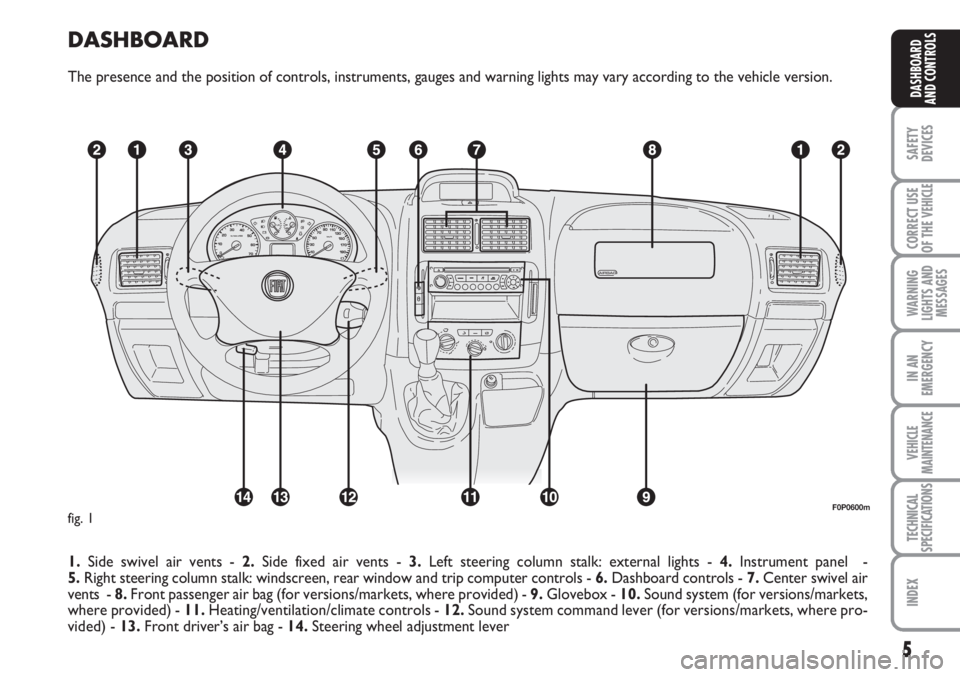
DASHBOARD
The presence and the position of controls, instruments, gauges and warning lights may vary according to the vehicle version.
1.Side swivel air vents - 2.Side fixed air vents - 3.Left steering column stalk: external lights - 4.Instrument panel -
5.Right steering column stalk: windscreen, rear window and trip computer controls - 6.Dashboard controls - 7.Center swivel air
vents - 8.Front passenger air bag (for versions/markets, where provided) - 9.Glovebox - 10.Sound system (for versions/markets,
where provided) - 11.Heating/ventilation/climate controls - 12.Sound system command lever (for versions/markets, where pro-
vided) - 13.Front driver’s air bag - 14. Steering wheel adjustment lever
5
SAFETY
DEVICES
CORRECT USE
OF THE
VEHICLE
WARNING
LIGHTS AND
MESSAGES
IN AN
EMERGENCY
VEHICLE
MAINTENANCE
TECHNICAL
SPECIFICATIONS
INDEX
DASHBOARD
AND CONTROLS
F0P0600mfig. 1
Page 15 of 210
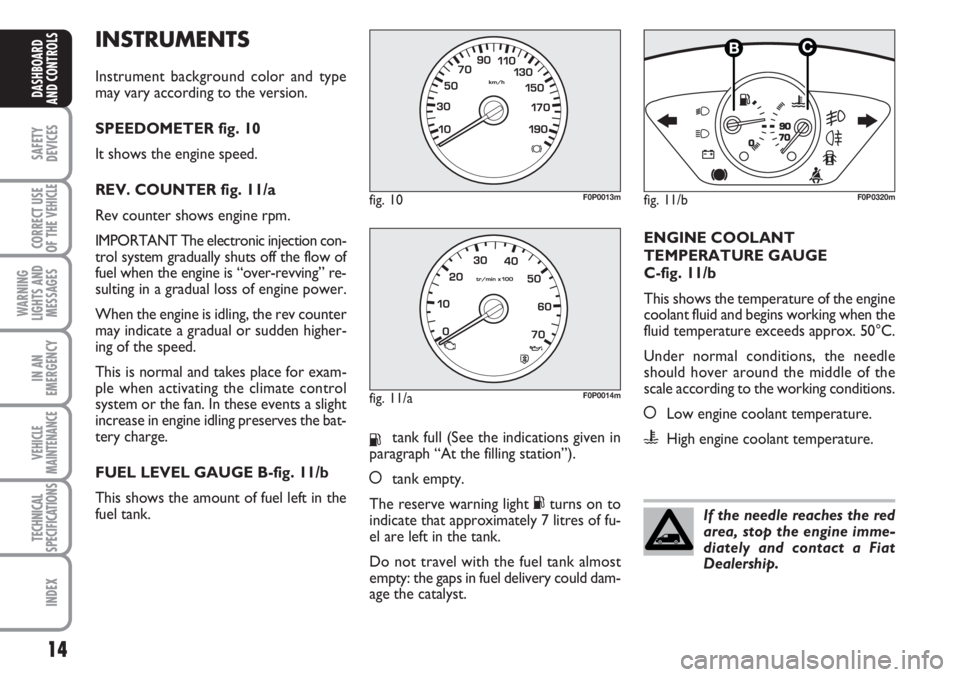
INSTRUMENTS
Instrument background color and type
may vary according to the version.
SPEEDOMETER fig. 10
It shows the engine speed.
REV. COUNTER fig. 11/a
Rev counter shows engine rpm.
IMPORTANT The electronic injection con-
trol system gradually shuts off the flow of
fuel when the engine is “over-revving” re-
sulting in a gradual loss of engine power.
When the engine is idling, the rev counter
may indicate a gradual or sudden higher-
ing of the speed.
This is normal and takes place for exam-
ple when activating the climate control
system or the fan. In these events a slight
increase in engine idling preserves the bat-
tery charge.
FUEL LEVEL GAUGE B-fig. 11/b
This shows the amount of fuel left in the
fuel tank.
Ktank full (See the indications given in
paragraph “At the filling station”).
åtank empty.
The reserve warning light Kturns on to
indicate that approximately 7 litres of fu-
el are left in the tank.
Do not travel with the fuel tank almost
empty: the gaps in fuel delivery could dam-
age the catalyst.ENGINE COOLANT
TEMPERATURE GAUGE
C-fig. 11/b
This shows the temperature of the engine
coolant fluid and begins working when the
fluid temperature exceeds approx. 50°C.
Under normal conditions, the needle
should hover around the middle of the
scale according to the working conditions.
åLow engine coolant temperature.uHigh engine coolant temperature.
fig. 10F0P0013m
14
SAFETY
DEVICES
CORRECT USE
OF THE
VEHICLE
WARNING
LIGHTS AND
MESSAGES
IN AN
EMERGENCY
VEHICLE
MAINTENANCE
TECHNICAL
SPECIFICATIONS
INDEX
DASHBOARD
AND CONTROLS
If the needle reaches the red
area, stop the engine imme-
diately and contact a Fiat
Dealership.
fig. 11/aF0P0014m
fig. 11/b
1/2
F0P0320m
Page 32 of 210
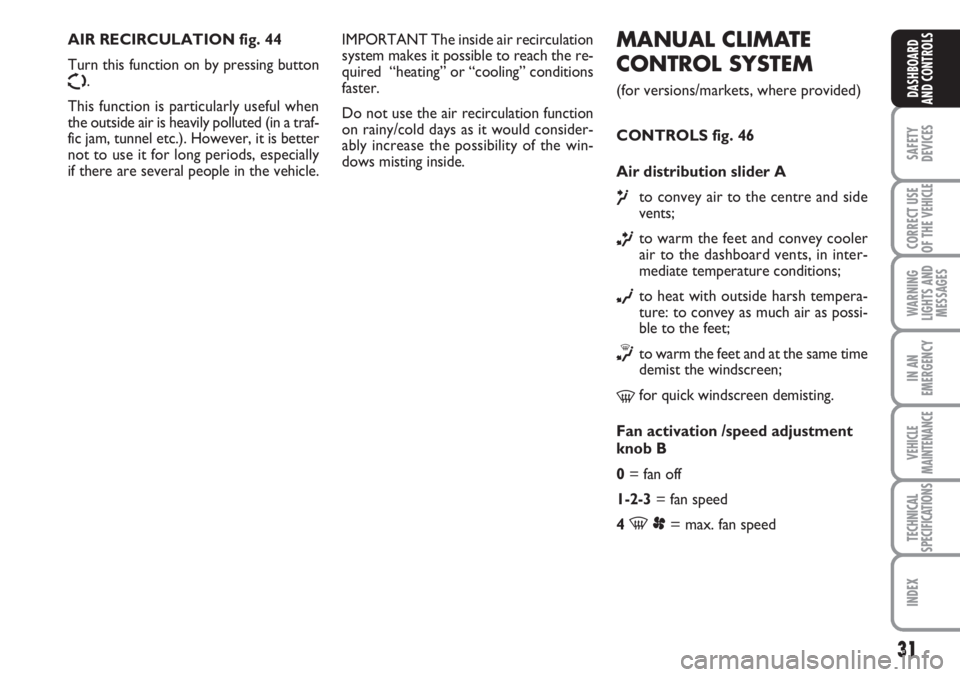
31
SAFETY
DEVICES
CORRECT USE
OF THE
VEHICLE
WARNING
LIGHTS AND
MESSAGES
IN AN
EMERGENCY
VEHICLE
MAINTENANCE
TECHNICAL
SPECIFICATIONS
INDEX
DASHBOARD
AND CONTROLS
MANUAL CLIMATE
CONTROL SYSTEM
(for versions/markets, where provided)
CONTROLS fig. 46
Air distribution slider A
μto convey air to the centre and side
vents;
∑to warm the feet and convey cooler
air to the dashboard vents, in inter-
mediate temperature conditions;
∂to heat with outside harsh tempera-
ture: to convey as much air as possi-
ble to the feet;
∏to warm the feet and at the same time
demist the windscreen;
-for quick windscreen demisting.
Fan activation /speed adjustment
knob B
0= fan off
1-2-3= fan speed
4
-p= max. fan speed AIR RECIRCULATION fig. 44
Turn this function on by pressing button
Ω.
This function is particularly useful when
the outside air is heavily polluted (in a traf-
fic jam, tunnel etc.). However, it is better
not to use it for long periods, especially
if there are several people in the vehicle.IMPORTANT The inside air recirculation
system makes it possible to reach the re-
quired “heating” or “cooling” conditions
faster.
Do not use the air recirculation function
on rainy/cold days as it would consider-
ably increase the possibility of the win-
dows misting inside.
Page 33 of 210
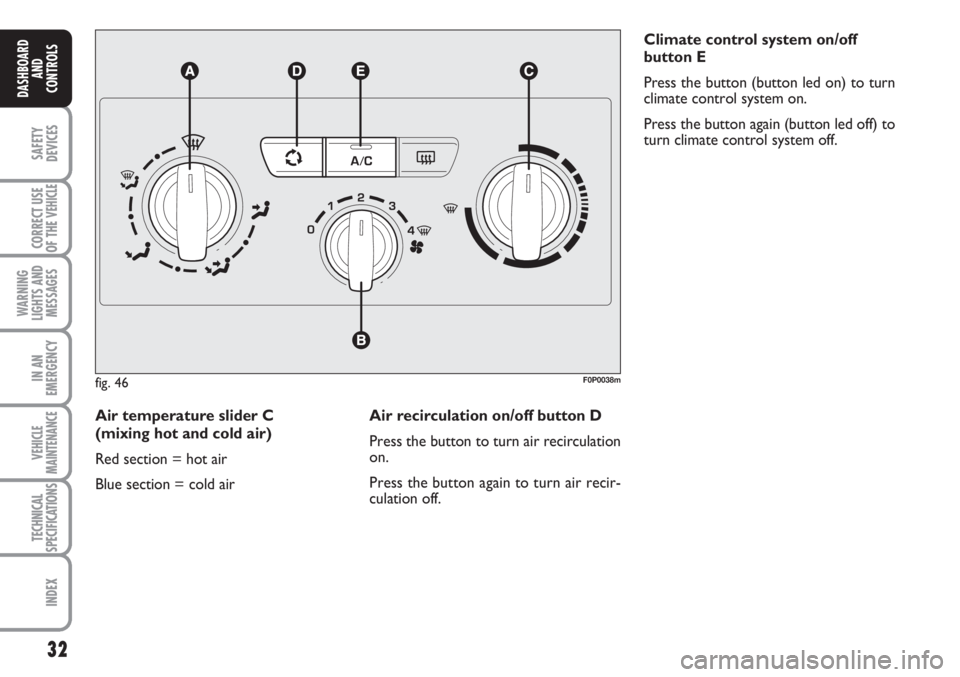
32
SAFETY
DEVICES
CORRECT USE
OF THE
VEHICLE
WARNING
LIGHTS AND
MESSAGES
IN AN
EMERGENCY
VEHICLE
MAINTENANCE
TECHNICAL
SPECIFICATIONS
INDEX
DASHBOARD
AND
CONTROLS
Air temperature slider C
(mixing hot and cold air)
Red section = hot air
Blue section = cold airClimate control system on/off
button E
Press the button (button led on) to turn
climate control system on.
Press the button again (button led off) to
turn climate control system off.
fig. 46F0P0038m
Air recirculation on/off button D
Press the button to turn air recirculation
on.
Press the button again to turn air recir-
culation off.
Page 34 of 210
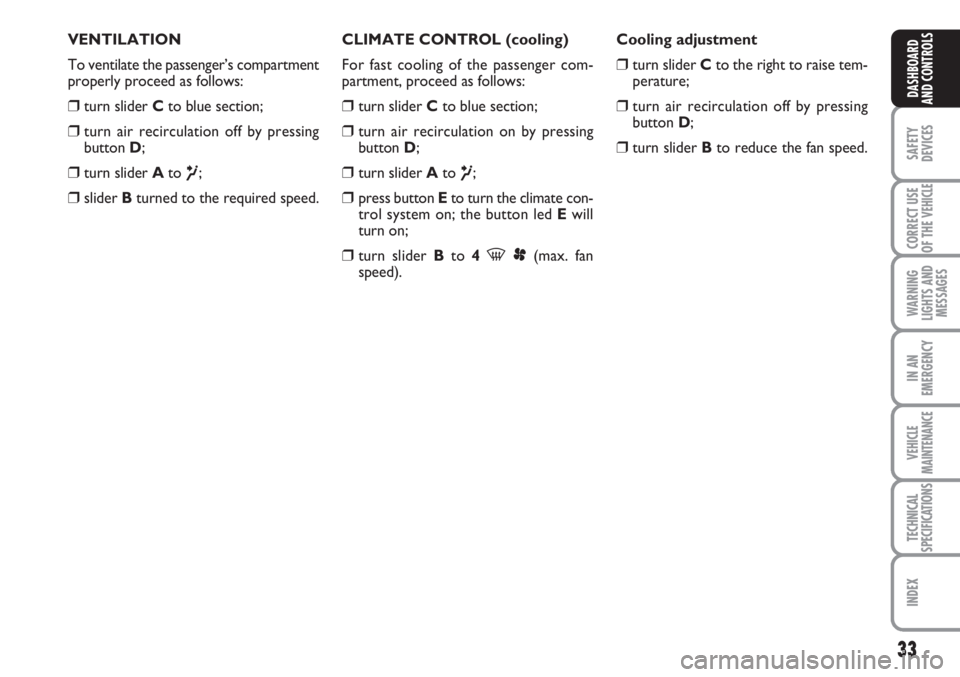
33
SAFETY
DEVICES
CORRECT USE
OF THE
VEHICLE
WARNING
LIGHTS AND
MESSAGES
IN AN
EMERGENCY
VEHICLE
MAINTENANCE
TECHNICAL
SPECIFICATIONS
INDEX
DASHBOARD
AND CONTROLS
VENTILATION
To ventilate the passenger’s compartment
properly proceed as follows:
❒turn slider Cto blue section;
❒turn air recirculation off by pressing
button D;
❒turn slider Ato μ;
❒slider Bturned to the required speed.CLIMATE CONTROL (cooling)
For fast cooling of the passenger com-
partment, proceed as follows:
❒turn slider Cto blue section;
❒turn air recirculation on by pressing
button D;
❒turn slider Ato μ;
❒press button Eto turn the climate con-
trol system on; the button led Ewill
turn on;
❒turn slider Bto 4-p(max. fan
speed).Cooling adjustment
❒turn slider Cto the right to raise tem-
perature;
❒turn air recirculation off by pressing
button D;
❒turn slider Bto reduce the fan speed.
Page 36 of 210
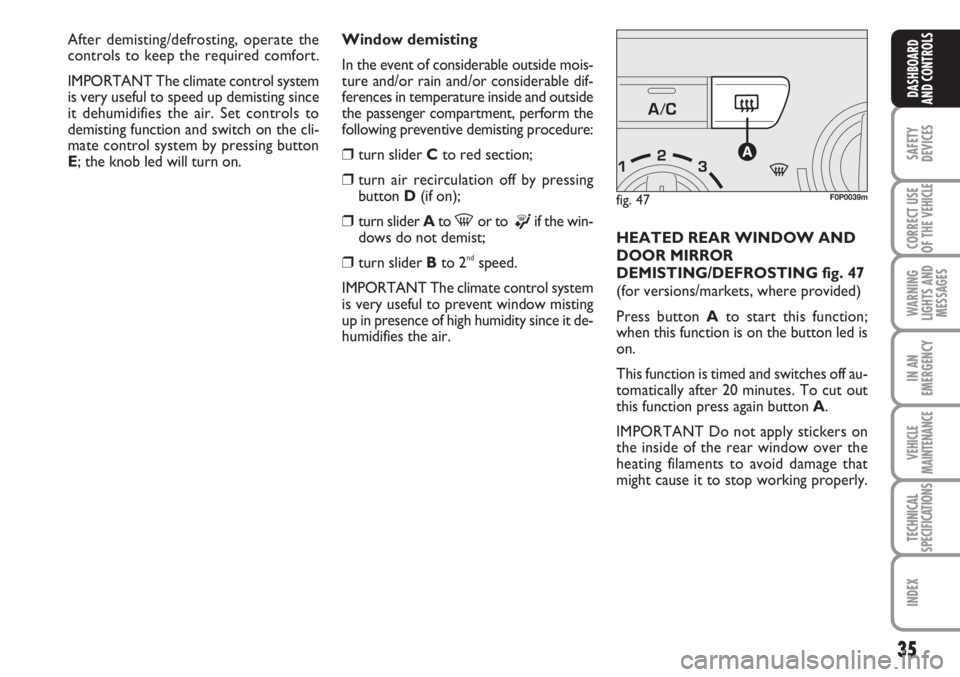
35
SAFETY
DEVICES
CORRECT USE
OF THE
VEHICLE
WARNING
LIGHTS AND
MESSAGES
IN AN
EMERGENCY
VEHICLE
MAINTENANCE
TECHNICAL
SPECIFICATIONS
INDEX
DASHBOARD
AND CONTROLS
Window demisting
In the event of considerable outside mois-
ture and/or rain and/or considerable dif-
ferences in temperature inside and outside
the passenger compartment, perform the
following preventive demisting procedure:
❒turn slider Cto red section;
❒turn air recirculation off by pressing
button D(if on);
❒turn slider Ato -or to ®if the win-
dows do not demist;
❒turn slider Bto 2ndspeed.
IMPORTANT The climate control system
is very useful to prevent window misting
up in presence of high humidity since it de-
humidifies the air.HEATED REAR WINDOW AND
DOOR MIRROR
DEMISTING/DEFROSTING fig. 47
(for versions/markets, where provided)
Press button Ato start this function;
when this function is on the button led is
on.
This function is timed and switches off au-
tomatically after 20 minutes. To cut out
this function press again button A.
IMPORTANT Do not apply stickers on
the inside of the rear window over the
heating filaments to avoid damage that
might cause it to stop working properly.
fig. 47F0P0039m
After demisting/defrosting, operate the
controls to keep the required comfort.
IMPORTANT The climate control system
is very useful to speed up demisting since
it dehumidifies the air. Set controls to
demisting function and switch on the cli-
mate control system by pressing button
E; the knob led will turn on.
Page 37 of 210
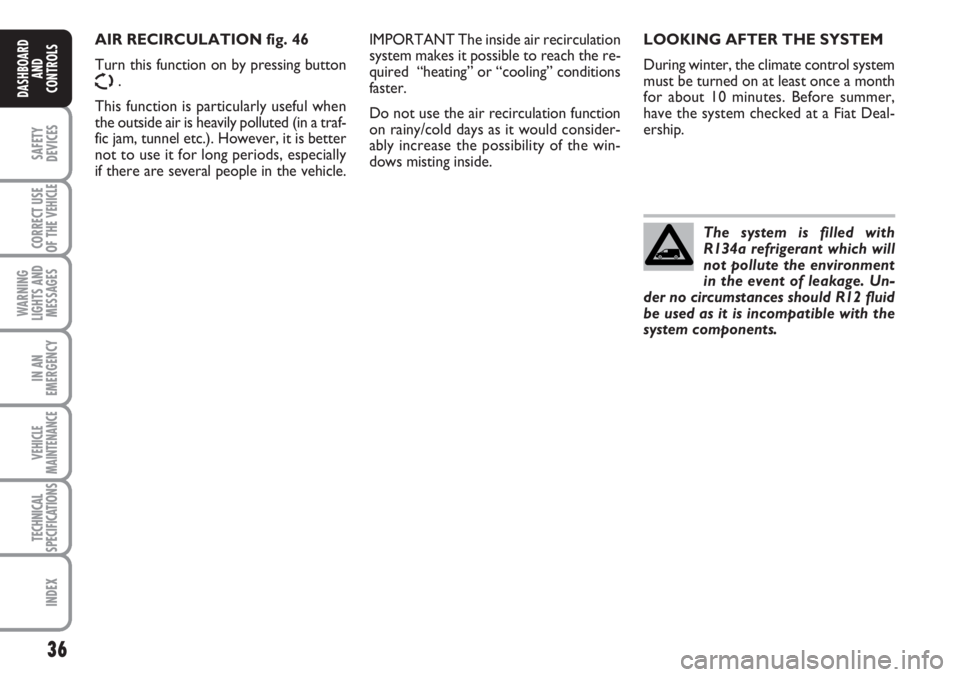
36
SAFETY
DEVICES
CORRECT USE
OF THE
VEHICLE
WARNING
LIGHTS AND
MESSAGES
IN AN
EMERGENCY
VEHICLE
MAINTENANCE
TECHNICAL
SPECIFICATIONS
INDEX
DASHBOARD
AND
CONTROLS
LOOKING AFTER THE SYSTEM
During winter, the climate control system
must be turned on at least once a month
for about 10 minutes. Before summer,
have the system checked at a Fiat Deal-
ership.
The system is filled with
R134a refrigerant which will
not pollute the environment
in the event of leakage. Un-
der no circumstances should R12 fluid
be used as it is incompatible with the
system components.IMPORTANT The inside air recirculation
system makes it possible to reach the re-
quired “heating” or “cooling” conditions
faster.
Do not use the air recirculation function
on rainy/cold days as it would consider-
ably increase the possibility of the win-
dows misting inside. AIR RECIRCULATION fig. 46
Turn this function on by pressing button
Ω.
This function is particularly useful when
the outside air is heavily polluted (in a traf-
fic jam, tunnel etc.). However, it is better
not to use it for long periods, especially
if there are several people in the vehicle.
Page 38 of 210
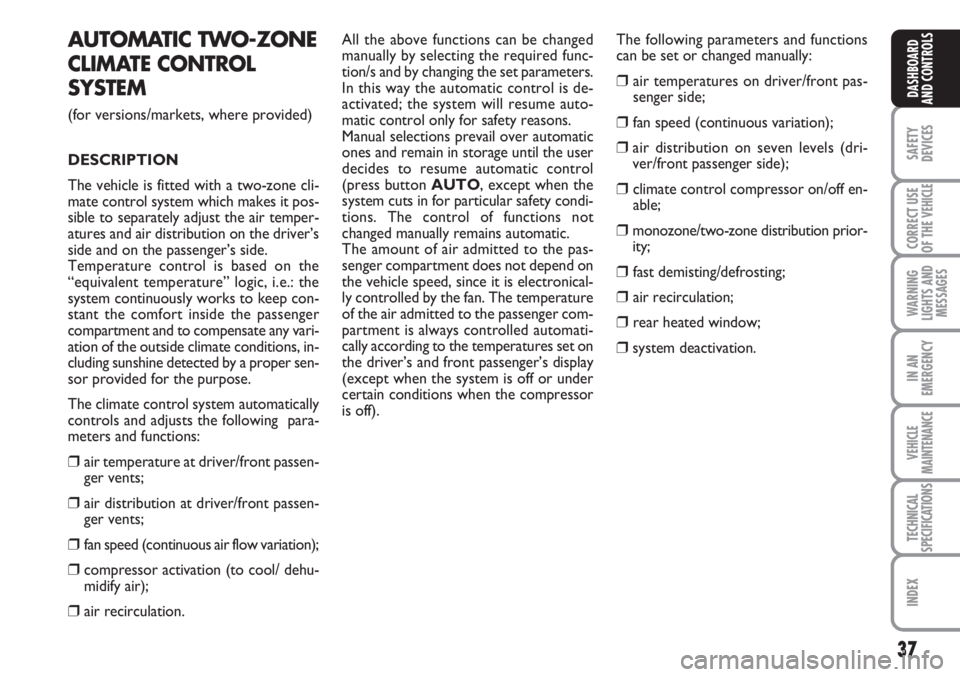
37
SAFETY
DEVICES
CORRECT USE
OF THE
VEHICLE
WARNING
LIGHTS AND
MESSAGES
IN AN
EMERGENCY
VEHICLE
MAINTENANCE
TECHNICAL
SPECIFICATIONS
INDEX
DASHBOARD
AND CONTROLS
AUTOMATIC TWO-ZONE
CLIMATE CONTROL
SYSTEM
(for versions/markets, where provided)
DESCRIPTION
The vehicle is fitted with a two-zone cli-
mate control system which makes it pos-
sible to separately adjust the air temper-
atures and air distribution on the driver’s
side and on the passenger’s side.
Temperature control is based on the
“equivalent temperature” logic, i.e.: the
system continuously works to keep con-
stant the comfort inside the passenger
compartment and to compensate any vari-
ation of the outside climate conditions, in-
cluding sunshine detected by a proper sen-
sor provided for the purpose.
The climate control system automatically
controls and adjusts the following para-
meters and functions:
❒air temperature at driver/front passen-
ger vents;
❒air distribution at driver/front passen-
ger vents;
❒fan speed (continuous air flow variation);
❒compressor activation (to cool/ dehu-
midify air);
❒air recirculation.All the above functions can be changed
manually by selecting the required func-
tion/s and by changing the set parameters.
In this way the automatic control is de-
activated; the system will resume auto-
matic control only for safety reasons.
Manual selections prevail over automatic
ones and remain in storage until the user
decides to resume automatic control
(press button AUTO, except when the
system cuts in for particular safety condi-
tions. The control of functions not
changed manually remains automatic.
The amount of air admitted to the pas-
senger compartment does not depend on
the vehicle speed, since it is electronical-
ly controlled by the fan. The temperature
of the air admitted to the passenger com-
partment is always controlled automati-
cally according to the temperatures set on
the driver’s and front passenger’s display
(except when the system is off or under
certain conditions when the compressor
is off).The following parameters and functions
can be set or changed manually:
❒ air temperatures on driver/front pas-
senger side;
❒ fan speed (continuous variation);
❒air distribution on seven levels (dri-
ver/front passenger side);
❒ climate control compressor on/off en-
able;
❒monozone/two-zone distribution prior-
ity;
❒ fast demisting/defrosting;
❒ air recirculation;
❒ rear heated window;
❒system deactivation.
Page 39 of 210
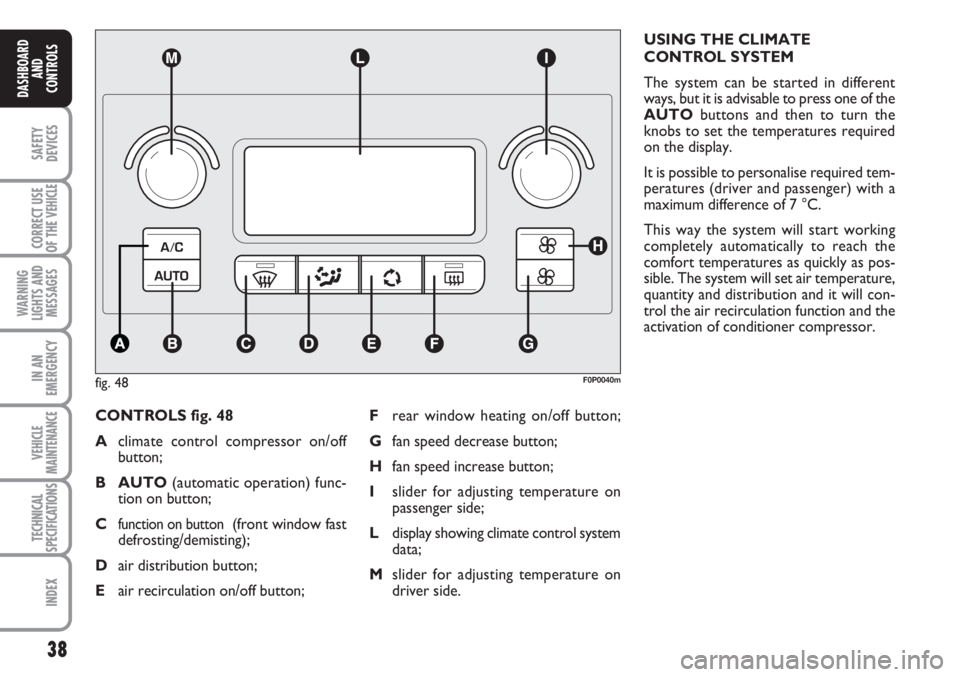
38
SAFETY
DEVICES
CORRECT USE
OF THE
VEHICLE
WARNING
LIGHTS AND
MESSAGES
IN AN
EMERGENCY
VEHICLE
MAINTENANCE
TECHNICAL
SPECIFICATIONS
INDEX
DASHBOARD
AND
CONTROLS
CONTROLS fig. 48
Aclimate control compressor on/off
button;
B AUTO(automatic operation) func-
tion on button;
C
function on button (front window fast
defrosting/demisting);
Dair distribution button;
Eair recirculation on/off button;USING THE CLIMATE
CONTROL SYSTEM
The system can be started in different
ways, but it is advisable to press one of the
AUTObuttons and then to turn the
knobs to set the temperatures required
on the display.
It is possible to personalise required tem-
peratures (driver and passenger) with a
maximum difference of 7 °C.
This way the system will start working
completely automatically to reach the
comfort temperatures as quickly as pos-
sible. The system will set air temperature,
quantity and distribution and it will con-
trol the air recirculation function and the
activation of conditioner compressor.
fig. 48F0P0040m
Frear window heating on/off button;
Gfan speed decrease button;
Hfan speed increase button;
Islider for adjusting temperature on
passenger side;
Ldisplay showing climate control system
data;
Mslider for adjusting temperature on
driver side.